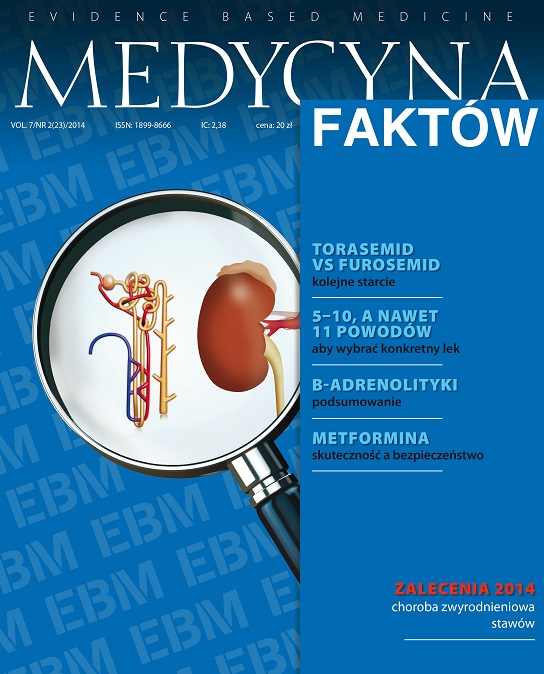Neuroprotective effect and nootropic activity of vinpocetine Reprint from: Winpocetyna. Znaczenie w praktyce klinicznej. Biblioteka Medycyny Faktów. Warszawa 2013: 21-30.
Main Article Content
Abstract
Vinpocetine is a drug known for many years and often used by both practitioners and specialists neurologists. It is generally believed that is supported by preclinical and clinical studies that vinpocetine improves the flow in the cerebral vessels by selectively reducing the vascular resistance without affecting systemic blood pressure. This is the basis of widespread use of vinpocetine in vascular diseases of the central nervous system, including stroke, vascular and hypertensive encephalopathy and vascular dementia. In addition, the mechanism of action of vinpocetine is probably more complex and multifactorial and includes inter alia neuroprotective and nootropic effects.
The aim of this article is the review and evaluation of already completed studies confirming the neuroprotective effect and nootropic activity of vinpocetine.
Nootropic activity and neuroprotective effect of vinpocetine can utilize it in the treatment of degenerative brain disorders with dementia, such as, primarily Alzheimer’s disease. However, diagnostics, especially the initial stages of Alzheimer’s disease is still with a high degree of uncertainty, making it difficult to assess the impact of treatment with vinpocetine on its course. Perhaps new electroneurophysiological technics will be able to help assess the progress of the disease and its modification (slowing) by treatment with vinpocetine.
Article Details
Copyright © by Medical Education. All rights reserved.
References
2. Karpati E., Biro K., Kukorelli T.: [Investigation of vasoactive agents with indole skeletons at Richter Ltd]. Acta Pharm. Hung. 2002; 72: 25-36.
3. Vinpocetine. Altern. Med. Rev. 2002; 7: 240-243.
4. Miskolczi P., Korma K., Polgar M., Vereczkey L.: Pharmacokinetics of vinpocetine and its main metabolite apovincaminic acid before and after the chronic oral administration of vinpocetine to humans. Eur. J Drug. Metab. Pharmacokinet. 1990; 15: 1-5.
5. Lohmann A., Dingler E., Sommer W., Schaffler K., Wober W., Schmidt W.: Bioavailability of vinpocetine and interference of the time of application with food intake. Arzneimittelforschung 1992; 42: 914-917.
6. Charakterystyka Produktu Leczniczego Cavinton Forte 10 mg, tabletki; z dnia 23.04.13.
7. Solti F., Iskum M., Czakó E.: Effect of ethyl apovincaminate on the cerebral circulation. Studies in patients with obliterative cerebral arterial disease. Arzneimittelforschung 1976; 26: 1945-1947.
8. Subhan Z., Hindmarch I.: Psychopharmacological effects of vinpocetine in normal healthy volunteers. Eur. J. Clin. Pharmacol. 1985; 28: 567-571.
9. Balestreri R., Fontana L., Astengo F.: A double-blind placebo controlled evaluation of the safety and efficacy of vinpocetine in the treatment of patients with chronic vascular senile cerebral dysfunction. J. Am. Geriatr. Soc. 1987; 35: 425-430.
10. Valikovics A., Csányi A., Németh L.: Study of the effects of vinpocetine on cognitive functions. Ideggyogy Sz. 2011; 64: 115-120.
11. Erdo S.L., Ning-Sheng C., Wolff J.R., Kiss B.: Vinpocetine protects against excitotoxic cell death in primary cultures of rat cerebral cortex. Europ. J. of Pharmacol. 1990; 187: 551-553.
12. Krieglstein J., Rischke R.: Vinpocetine increases the neuroprotective effect of adenosine in vitro. Eur. J. Pharmacol. 1991; 205: 7-10.
13. Kiss B.L., Ning-Sheng C., Erdo S.: Vinpocetine preferentially antagonizes quisqualate / AMPA receptor responses: evidence from release and ligand binding studies. Eur. J. Pharmacol. 1991; 209: 109-112.
14. Kaneko S., Sugimura M., Inoue T., Satoh M.: Effects of several cerebroprotectives drugs on NMDA channel function: evaluation using Xenopus oocytes and [3H]MK-801 binding. Eur. J. Pharmacol. – Molecular Pharmacology Section 1991; 207: 119-128.
15. Molnar P., Erdo S.: Vinpocetine is as potent as phenytoine to block voltage-gated Na+ channels in rat cortical neurons. Eur. J. Pharmacol. 1995; 273: 303-306.
16. Neurologia Merritta. Rowland L.P. (red.), Kwieciński H. i Kamińska A.M. (tłum.). Elsevier Urban & Partner, Wrocław 2008.
17. Bear M., Connors B.W., Paradiso M.A.: Neuroscience. Exploring the Brain. Lippincott Williams & Wilkins 2007.
18. Duncan C. et al.: Event-related potentials in clinical research. Clinical Neurophysiology 2009; 120: 1883-1908.
19. Derkowski W., Derkowska J., Kędzia A.: Komputerowo uśredniane wzrokowe i słuchowe potencjały wywołane u chorych na chorobę Alzheimera leczonych donepezylem. Komputerowe wspomaganie badań naukowych. Tom XVIII. Wrocław – Polanica Zdrój 2011: 229-236.
20. Derkowski W., Kędzia A.: Cognitive computer-averaged evoked potentials in monitoring progress and donepezil treatment of Alzheimer’s disease. The computer-aided scientific research. Wrocławskie Towarzystwo Naukowe, Wrocław 2012: 13-21.
21. Derkowski W.: Event-related potentials in patients with epilepsy treated with levetiracetam. Epilepsia 2012; 53(supl. 5): 195.

